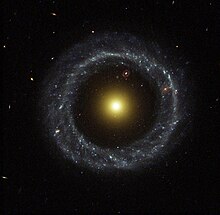The Lost Symbol
Appearance

The Lost Symbol (2009) is a mystery novel by American writer Dan Brown. It is the third book in a series that follows Harvard University symbologist Robert Langdon, after The Da Vinci Code and Angels & Demons.
Quotes
[edit]

- In 1991, a document was locked in the safe of the director of the CIA. The document is still there today. Its cryptic text includes references to an ancient portal and an unknown location underground. The document also contains the phrase "It’s buried out there somewhere."
All organizations in this novel exist, including the Freemasons, the Invisible College, the Office of Security, the SMSC, and the Institute of Noetic Sciences.
All rituals, science, artwork, and monuments in this novel are real.- Acknowledgements
- The secret is how to die.
Since the beginning of time, the secret had always been how to die.- Prologue
- He gazed up through the rain-speckled glass ceiling at the mountainous form of the illuminated Capitol Dome overhead. It was an astonishing building. High atop her roof, almost three hundred feet in the air, the Statue of Freedom peered out into the misty darkness like a ghostly sentinel. Langdon always found it ironic that the workers who hoisted each piece of the nineteen-and-a-half-foot bronze statue to her perch were slaves — a Capitol secret that seldom made the syllabi of high school history classes.
- Ch. 6
- Sorry, but the word occult, despite conjuring images of devil worship, actually means "hidden" or "obscured." In times of religious oppression, knowledge that was counterdoctrinal had to be kept hidden or "occult," and because the church felt threatened by this, they redefined anything "occult" as evil, and the prejudice survived.
- Robert Langdon, in Ch. 6
- Don't tell anyone, but on the pagan day of the sun god Ra, I kneel at the foot of ancient instrument of torture and consume ritualistic symbols of blood and flesh....And if any of you care to join me, come to the Harvard chapel on Sunday, kneel beneath the crucifix, and take Holy Communion.
- Robert Langdon, in Ch. 6
- Our connection was fine professor, and I have an extremely low tolerance for bullshit
- Director Inoue Sato, in Ch. 16
- Knowledge is a tool, and like all tools, its impact is in the hands of the user.
- Trish Dunne, in Ch. 18
- America’s intended destiny has been lost to history.
The forefathers who founded this capital city first named her “Rome.” They had named her river the Tiber and erected a classical capital of pantheons and temples, all adorned with images of history’s great gods and goddesses — Apollo, Minerva, Venus, Helios, Vulcan, Jupiter. In her center, as in many of the great classical cities, the founders had erected an enduring tribute to the ancients — the Egyptian obelisk. This obelisk, larger even than Cairo’s or Alexandria’s, rose 555 feet into the sky, more than thirty stories, proclaiming thanks and honor to the demigod forefather for whom this capital city took its newer name.
Washington.- Ch. 20
- Don't tell me, bookish bachelor seeking single Noetic Scientist?
- Katherine Solomon, in Ch. 45
- Wealth is commonplace, but wisdom is rare.
- Peter Solomon, in Ch. 61
- Although many people erroneously interpreted apocalypse as a cataclysmic end of the world, the word literally signified an “unveiling,” predicted by the ancients to be that of great wisdom. The coming age of enlightenment. Even so, Langdon could not imagine such a vast change being ushered in by . . . a word.
- Ch. 126
- Throughout history, the circumpunct has been all things to all people — it is the sun god Ra, alchemical gold, the all-seeing eye, the singularity point before the Big Bang...
- Robert Langdon, in Ch. 126
- Sometimes all it takes is a tiny shift of perspective to see something familiar in a totally new light.
- Peter Solomon, in Ch. 126

